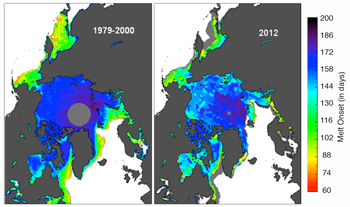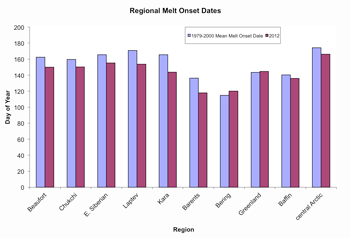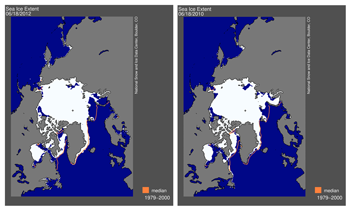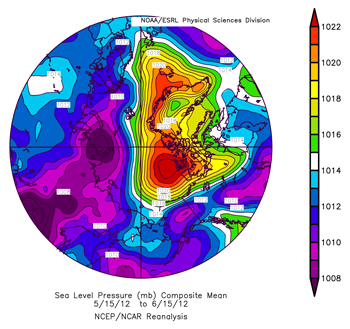Arctic sea ice continued to track at levels far below average through the middle of July, with open water in the Kara and Barents seas reaching as far north as typically seen during September. Melt onset began earlier than normal throughout most of the Arctic.
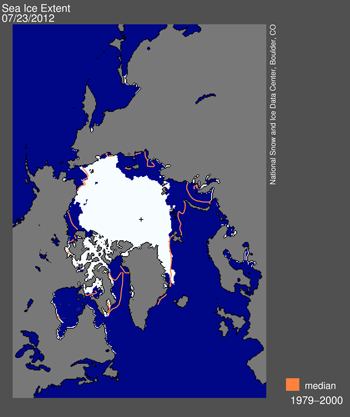
Figure 1. Arctic sea ice extent for July 23, 2012 was 7.32 million square kilometers (2.82 million square miles). The orange line shows the 1979 to 2000 median extent for that day. The black cross indicates the geographic North Pole. Sea Ice Index data. About the data
Credit: National Snow and Ice Data Center
High-resolution image
Overview of conditions
As of July 23, 2012, sea ice extent was 7.32 million square kilometers (2.82 million square miles). On the same day last year, ice extent was 7.22 million square kilometers (2.78 million square miles), the record low for this day.
Arctic sea ice extent continued to track at very low levels, setting daily record lows for the satellite era for a few days in early July. Extent is especially low in the Barents, Kara, and Laptev seas. In the Barents and Kara seas, the area of open water extends to the north coasts of Franz Josef Land and Severnaya Zemlya, as far north as typically seen during September, the end of the summer melt season. Polynyas in the Beaufort and East Siberian seas continued to expand during the first half of July. By sharp contrast, ice extent in the Chukchi Sea remains near normal levels. In this region the ice has retreated back to the edge of the multiyear ice cover. Ice cover in the East Greenland Sea, while of generally low concentration, remains slightly more extensive than normal.
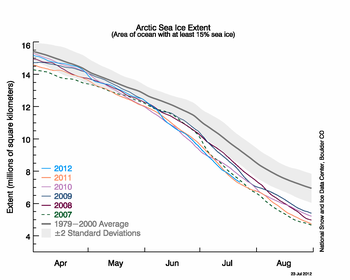
Figure 2. The graph above shows Arctic sea ice extent as of July 23, 2012, along with daily ice extent data for the previous five years. 2012 is shown in blue, 2011 in orange, 2010 in pink, 2009 in navy, 2008 in purple, and 2007 in green. The gray area around the average line shows the two standard deviation range of the data. Sea Ice Index data.
Credit: National Snow and Ice Data Center
High-resolution image
Conditions in context
The first part of July was once again dominated by high sea level pressure over the Beaufort Sea, combined with low sea level pressure over Siberia and Alaska. As discussed in last month’s post, this pressure pattern tends to promote above-average temperatures and enhances ice transport out of the Arctic through Fram Strait. Beginning July 11th, the pressure pattern changed as cyclones moved into the central Arctic Ocean, bringing in cooler temperatures and helping to slow ice loss. Air temperatures at the 925 hPa level (about 3000 feet) in the central Arctic and the Beaufort Sea were 1 to 4 degrees Celsius (2 to 7 degrees Fahrenheit) above normal as averaged from July 1 to July 14. In the Beaufort and Chukchi seas, the sea ice has retreated to the edge of the multiyear ice cover. As a result of the anomalously high air temperatures, melt over the multiyear ice cover is extensive and ice concentrations are low. Anomalously low air temperatures for that period were found in the Barents, Kara, and East Greenland seas (1 to 3 degrees Celsius, or 2 to 6 degrees Fahrenheit, below the 1981 to 2010 climatology).
Early melt onset
The timing of seasonal melt onset, which can be estimated from satellite passive microwave data, plays an important role in the amount of ice that melts each summer. Unusually early melt onset means an early reduction in the surface albedo, allowing for more solar heating of the ice, which in turn allows melt ponds and open water areas to develop earlier in the melt season. In 2012, melt began earlier than normal (as compared to averages for the period 1979 to 2000) throughout most of the Arctic, the exceptions being the Bering Sea and the East Greenland Sea. Melt in the Kara and Barents seas began more than two weeks earlier than normal. Melt onset for the Laptev Sea region as a whole started on June 1 and was the earliest seen in the satellite record. Melt began 12 and 9 days earlier than normal averaged over the Beaufort and Chukchi seas, respectively.
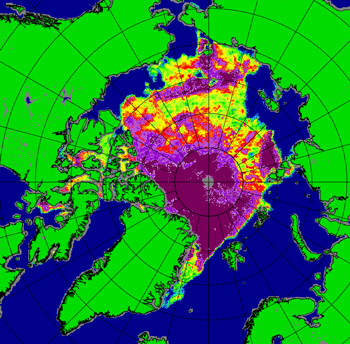
Figure 4. This composite image from the SSMIS instrument obtained on July 23, 2012 shows areas of low ice concentration in the Beaufort and Chukchi seas, the Canadian Archipelago, the East Greenland Sea, and north of Siberia. Purple indicates areas of high sea ice concentration, while yellow and red indicate lower ice concentration. Blue shows open water and green shows land.
Credit: National Snow and Ice Data Center courtesy IUP Bremen
High-resolution image
Low ice concentrations
NSIDC uses satellite data from the Special Sensor Microwave Imager (SSM/I) and the Special Sensor Microwave Imager/Sounder (SSMIS) instruments, in part because they provide the longest consistent time series of data. However, more recent sensors such as the Advanced Microwave Scanning Radiometer-Earth Observing System (AMSR-E) provide a more detailed perspective. In particular, we can examine ice concentration, which tells us how much ice is in a pixel, providing information on how vulnerable the ice may be to summer melting.
In October 2011, the AMSR-E instrument on board the NASA Aqua satellite ceased operation, dealing a blow to the science community. This is because its higher spatial resolution and advanced technology provided detailed ice information to complement the long-term record of the Special Sensor Microwave Imager/Sounder (SSMIS) instrument. However, the Japanese Aerospace Exploration Agency (JAXA) successfully launched a new satellite called Shizuku, or Global Change Observation Mission 1st-Water (GCOM-W1), on May 18, 2012. The Shizuku carries a new Advanced Microwave Scanning Radiometer (AMSR2) instrument, a sensor similar to AMSR-E. As soon as calibration and validation of AMSR2 are complete, the University of Bremen will once again produce maps of sea ice concentration at a fairly high resolution (about 6 kilometers).
In the meantime, the University of Bremen offers sea ice concentration maps from the lower-resolution SSMIS. The July 23 chart shows areas of low sea ice concentration in the Beaufort and Chukchi seas, the Canadian Archipelago, the East Greenland Sea, and north of Siberia. In the Beaufort and Chukchi seas, low ice concentrations and polynyas are found over areas of multiyear sea ice, where open water areas have developed between individual multiyear ice floes and significant ponding on the ice is observed. Low ice concentrations mean a low surface albedo, allowing for more of the sun’s energy to be absorbed, melting even more sea ice. This makes the multiyear ice in the Beaufort and Chukchi seas vulnerable to melting out this summer.
